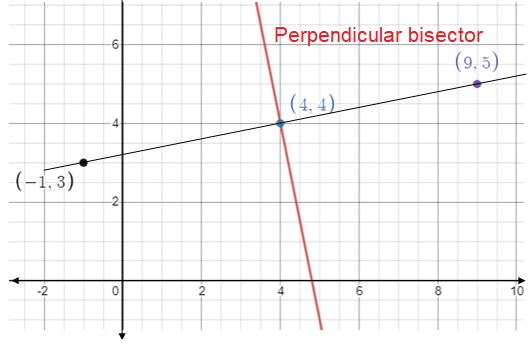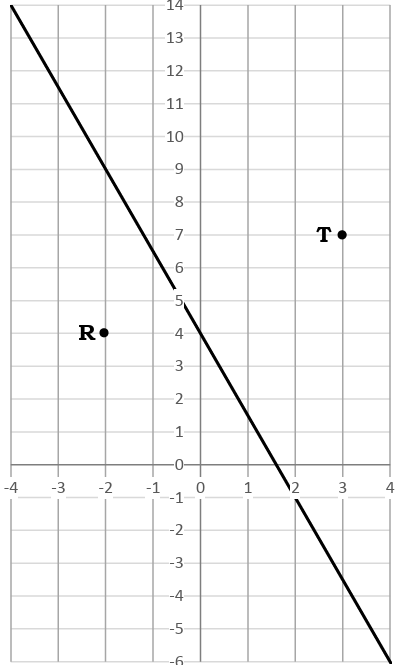HOW TO FIND EQUATION OF PERPENDICULAR BISECTOR
A perpendicular bisector is a line that bisects (cuts in half) another line and it is at right angles to the line.
Let A and B be the endpoint of the line segment. To find the equation of the perpendicular bisector, we follow the steps given below.
(i) Find the midpoint of the line segment which has endpoints A and B.
(ii) Slope of the perpendicular line = -1/Slope of the line AB
(iii) To find equation, we use
y - y1 = m(x - x1)
Here (x1, y1) is the midpoint and m is the slope.
Problem 1 :
Find the equation of the perpendicular bisector of P(9, 5) and Q(-1, 3).
Solution :
Midpoint of the line segment PQ :
Midpoint = (x1 + x2)/2, (y1 + y2)/2
= (9 + (-1))/2, (5 + 3)/2
= 8/2, 8/2
= (4, 4)
Slope of the line joining the points P and Q :
m = (y2 - y1) / (x2 - x1)
m = (3 - 5)/(-1 - 9)
m = -2/-10
m = 1/5
Slope of the perpendicular line = -1/(1/5) = -5
The perpendicular bisector is also a line which is perpendicular to the line joining the points P and Q and it will pass through the point (4, 4).
(y - y1) = m(x - x1)
y - 4 = -5(x - 4)
y - 4 = -5x + 20
y = -5x + 24

Problem 2 :
Given that the triangle QRS have vertices (-3, 1), (-4, -2) and (7, 0).Find the equation of the perpendicular bisector of RS.
Solution :
Let the vertices be Q(-3, 1), R(-4, -2) and S(7, 0)
Midpoint of the line joining the points RS :
midpoint = (x1 + x2)/2, (y1 + y2)/2
= (-4 + 7)/2, (-2 + 0)/2
= 3/2, -2/2
= (3/2, -1)
Slope of the line RS :
m = (0 + 2)/(7 + 4)
m = 2/11
Slope of the perpendicular bisector = -11/2
Equation of perpendicular bisector :
(y + 1) = (-11/2)(x - (3/2))
2(y + 1) = -11(x - (3/2))
2y + 2 = -11x + 33/2
2y = -11x + (33/2) - 2
2y = -11x + 29/2
y = (-11/2)x + (29/4)
Problem 3 :
Pictured to the right is the straight line S1 and the points R and T.
(a) Find the equation of S1.
(b) S2 is perpendicular to S1 and passes through R. Find the equation of S2.
(c) Does S2 pass through T?

Solution :
a) Equation of the line S1 shown :
Points on the line shown are (0, 4) and (-2, 9)
y-intercept = 4
Slope = (9 - 4) / (-2 - 0)
= 5/(-2)
= -5/2
y = (-5/2) x + 4
b) Slope of line S2 which is perpendicular to S1 = -1/(-5/2)
= 2/5
Equation of perpendicular line S2 passes through R :
T(-2, 4)
y - 4 = (2/5) (x - (-2))
5(y - 4) = 2(x + 2)
5y - 20 = 2x + 4
2x - 5y + 4 + 20 = 0
2x - 5y + 24 = 0
c) Check if the point T lies on the line :
T(3, 7)
Applying x = 3 and y = 7
2(3) - 5(7) + 24 = 0
6 - 35 + 24 = 0
-29 + 24 = 0
Since the point T does not satisfy the equation, T does not lie on the line S2.
Problem 4 :
A = (-3, -2) B = (6, 4) The line C has equation 4y + 6x = 13. Show that C is perpendicular to AB.
Solution :
6x + 4y = 13
4y = -6x + 13
y = (-6/4)x + (13/4)
y = (-3/2)x + (13/4)
Slope of the line C = -3/2
Slope of the line joining the points A = (-3, -2) B = (6, 4)
= (4 - (-2)) / (6 - (-3))
= (4 + 2) / (6 + 3)
= 6/9
= 2/3
Since the product of these two slopes is equal to -1. These two lines are perpendicular.
Problem 5 :
Line I passes through the points (5, 6) and (8, -3). Line J passes through the points (-2, -2) and (4, k). Lines I and J are perpendicular. Find k.
Solution :
Slope of the line joining the points (5, 6) and (8, -3).
= (-3 - 6) / (8 - 5)
= -9/3
= -3
Slope of the line L = -3
Slope of the line J passes through the points (-2, -2) and (4, k).
= (k - (-2)) / (4 - (-2))
= (k + 2) / (4 + 2)
= (k + 2) / 6
-3[(k + 2) / 6] = -1
3(k + 2) = 6
3k + 6 = 6
3k = 6 - 6
k = 0
So, the value of k is 0.
Recent Articles
-
Finding Range of Values Inequality Problems
May 21, 24 08:51 PM
Finding Range of Values Inequality Problems -
Solving Two Step Inequality Word Problems
May 21, 24 08:51 AM
Solving Two Step Inequality Word Problems -
Exponential Function Context and Data Modeling
May 20, 24 10:45 PM
Exponential Function Context and Data Modeling